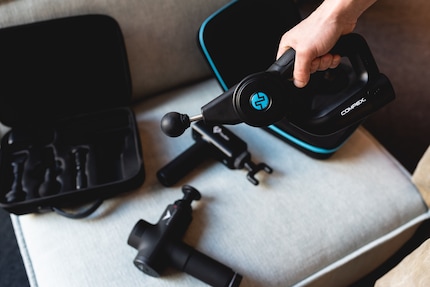
Background information
New massage guns from Therabody: what they can and can’t do
by Patrick Bardelli

They have power, look professional and are no longer just used by physiotherapists. "Massage guns" are conquering the mass market. Physiotherapy lecturer Prof Dr Slavko Rogan talks about the benefits, risks and empty promises in an interview.
The devices are humming. So is the business. Massage guns such as the Theragun ("this is massage reinvented") or the Hypervolt ("built to reinvent the massage experience") are so well received that a number of manufacturers have launched similar models on the market. Here too, the choice is getting bigger and bigger. The impact drill-like things promise an "ultimate deep massage" and all kinds of positive effects. Real miracle weapons then? If you do a bit of googling online or browse social media channels, you might think so. The expert categorises the devices in a more differentiated way.
What do you think of "massage guns" in general?
Prof. Dr Slavko Rogan, lecturer in physiotherapy at the Bern University of Applied Sciences School of Health:
I first need to expand a little. In physiotherapy and massage, people have always worked with aids. For example, with the Deuserstäbchen. This is a wooden or metal stick that can also be used to treat deeper points in the muscles. Ultimately, a massage gun is a further development of the Deuser stick. In the right hands, it is a good tool. You treat, find a point and go a little deeper. So the principle is nothing new.
The devices are quite powerful and can deliver up to 46 strokes per second. What effect does a percussion massage with such a high frequency have?
The advantage of such a device is that I get deeper into the muscles and don't need as much force. A lot of stimuli are applied to the muscles and tissue so that the muscles can relax or regain a certain tension. That is the experience. There is no scientific evidence of effectiveness.
The list of positive effects that are advertised is long: among other things, sore muscles and muscle stiffness are supposed to be alleviated, the regeneration time shortened, the range of motion improved and the healing process after muscle injuries accelerated.
With all these promises, the manufacturers simply want to sell their devices. I see their main benefit as relieving some tension and promoting blood circulation in the relevant area. In the case of back pain, for example, it can be that certain muscles have very hard and painful tension.
Which parts of the body shouldn't be treated with it?
Massage guns should not be used on the abdomen or head and you should also be careful around the back of the knee. If you want to buy one, you should definitely consult a physiotherapist. They can explain the handling and areas of application.

There are various attachments for the devices. Balls and disc-shaped attachments for large-area treatment as well as forks and finger-like attachments that massage very selectively. What do you need to consider when making your choice?It depends on the therapist's point of view and approach. I would use small-area attachments as I like to find the trigger points and treat them specifically. Other colleagues say: No, you have to treat large areas on the outside first.
The devices are not only used by people with therapeutic training
A physiotherapist can instruct a layperson, give them a muscle map and say: you should treat there, not there. For example, there are points on the tendon plate on the outside of the thigh that are very easy to point out and work on specifically.
How long should you stay on one point at most? The manufacturer Compex, for example, writes: no longer than 1 minute.
It depends on the situation. When I treat a point, I notice at some point that the tension is released and it gets better. From this point onwards, you can continue for a few more seconds and should then stop. If the pain gets worse during treatment, you should definitely not continue.
After fascia rollers and rollers with a vibration core, "massage guns" are the next big thing. Can you understand why these devices are so trendy?I can understand that. They are tools that can be used very well in therapy and they certainly provide support for professionally trained laypeople. But they do not replace therapy. They are just a supplement. Many people jump on such "novelties", but the principle is nothing new. That's why the whole thing needs to be viewed critically.
Simple writer and dad of two who likes to be on the move, wading through everyday family life. Juggling several balls, I'll occasionally drop one. It could be a ball, or a remark. Or both.
Interesting facts about products, behind-the-scenes looks at manufacturers and deep-dives on interesting people.
Show all